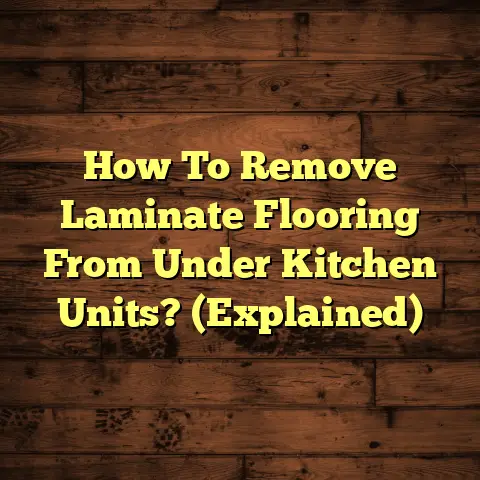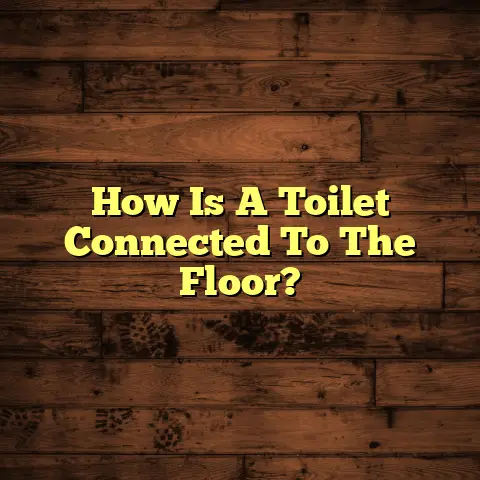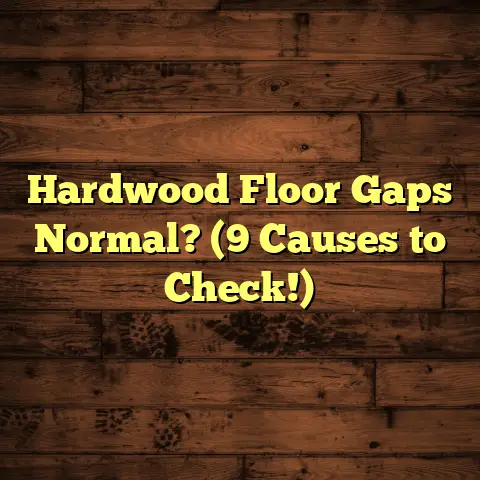Repair Buckled Floors (1 Hour FIX Guide!)
Buckled floors aren’t just an eyesore; they can be a sign of bigger problems lurking beneath the surface.
In this guide, I’m going to walk you through how to tackle this issue head-on, often in under an hour!
We’ll cover everything from understanding why floors buckle to budget-friendly fixes and even some preventative measures.
Let’s dive in and get those floors looking shipshape again!
Section 1: Understanding Buckled Floors
So, what exactly is a buckled floor?
Simply put, it’s when your flooring material starts to lift or warp, creating an uneven surface.
Think of it like this: your floor is supposed to be flat and happy, but something’s causing it stress, making it bulge or ripple.
How Buckling Manifests:
- Hardwood: You’ll see individual planks rising up, sometimes creating sharp edges.
- Laminate: Similar to hardwood, but the buckling might be more widespread due to the core material.
- Vinyl: Can bubble or ripple, especially sheet vinyl. Planks may lift at the seams.
The Usual Suspects: Common Causes
I’ve seen floors buckle for a few key reasons. Let’s break them down:
Water Damage: This is the big one!
Leaks, spills, or even flooding can soak into your flooring and cause it to expand.
Think leaky pipes, overflowing washing machines, or even just a pet accident that wasn’t cleaned up quickly enough.- According to the EPA, moisture problems can lead to mold growth within 24-48 hours.
- Humidity Levels: Excessive humidity can have the same effect as a water leak, causing the flooring to absorb moisture from the air.
- Improper Installation: If the flooring wasn’t installed correctly, it might not have enough room to expand and contract with temperature changes.
This is especially common with floating floors like laminate and some vinyl. - Subfloor Issues: An uneven or damaged subfloor can put stress on the flooring above, leading to buckling.
- Temperature Fluctuations: Extreme temperature changes can cause expansion and contraction, which can lead to buckling over time.
Why You Can’t Ignore It:
Leaving a buckled floor unattended is like ignoring a cough that could be pneumonia.
- Increased Repair Costs: The longer you wait, the more extensive the damage can become.
What starts as a small buckle could lead to needing a full floor replacement. - Safety Hazards: Tripping hazards are a serious concern, especially for young children and the elderly.
Those sharp edges can also cause cuts and scrapes. - Mold and Mildew: If moisture is the culprit, you could be creating a breeding ground for mold and mildew, which can cause health problems.
Section 2: Budget Options for Repairing Buckled Floors
Alright, let’s talk money.
I know that’s what you’re really thinking about!
Fixing floors doesn’t have to break the bank.
Let’s explore some budget-friendly options, from DIY fixes to when you really need to call in a pro.
Assessing the Damage: DIY or Pro?
Before you start swinging a hammer, take a good, hard look at the damage.
Ask yourself these questions:
- How widespread is the buckling? Is it just a small area, or is it the entire room?
- What type of flooring is it? Some materials are easier to work with than others.
- What’s the source of the moisture? If you can’t identify and fix the source, the buckling will just come back.
- Are you comfortable with basic DIY tasks? If you’re not handy, it’s best to leave it to the professionals.
Signs You Can DIY:
- Small, isolated areas of buckling
- The source of moisture is easily identifiable and fixable
- You have some experience with basic home repairs
Signs You Need a Pro:
- Widespread buckling
- You can’t find the source of the moisture
- The subfloor is damaged
- You’re not comfortable with DIY repairs
DIY Repair Options: Get Your Hands Dirty (and Save Some Cash!)
If you’re feeling brave and the damage is minor, here are some cost-effective DIY methods I’ve seen work wonders:
Moisture Barriers: If moisture from below is the issue, installing a moisture barrier can help prevent future buckling.
These are typically polyethylene sheets that are laid down before the flooring is installed.- Estimated Cost: \$0.20 – \$0.50 per square foot.
-
Adjusting Humidity Levels: A dehumidifier can help lower humidity levels in your home, preventing moisture from being absorbed by the flooring.
-
Estimated Cost: \$50 – \$200 for a dehumidifier (depending on size and features).
-
Re-seating Planks: Sometimes, all you need to do is carefully remove the affected planks, clean the area underneath, and re-seat them.
You might need to use a bit of flooring adhesive to keep them in place. -
Estimated Cost: \$10 – \$30 for flooring adhesive.
-
Using a Heat Gun: For minor buckling in vinyl or laminate, a heat gun can sometimes help soften the material and allow it to flatten out.
Be careful not to overheat the flooring, as this can damage it. -
Estimated Cost: \$20 – \$50 for a heat gun.
-
Replacing Damaged Planks: If the damage is too severe to repair, you might need to replace the affected planks.
This is easier if you have extra planks from the original installation. -
Estimated Cost: Varies depending on the type of flooring and the number of planks needed.
Temporary Solutions: Band-Aids for Your Floors
Sometimes, you need a quick fix to make the buckling less noticeable while you figure out a permanent solution.
Here are a few budget-friendly temporary fixes I’ve recommended over the years:
- Area Rugs: Strategically placed area rugs can cover up the buckled areas and prevent tripping hazards.
- Furniture Placement: Arrange furniture to hide the buckling and create a more visually appealing space.
- Floor Mats: Place floor mats in high-traffic areas to protect the flooring from further damage.
- Heavy Books or Weights: For minor buckling, you can try placing heavy books or weights on the affected area to flatten it out.
This might take several days or even weeks to work.
Professional Help: When to Call in the Cavalry
Let’s be honest, sometimes you just need a professional.
Here’s when it’s worth shelling out the extra cash:
- Extensive Damage: If the buckling is widespread or the subfloor is damaged, you’ll need a professional to assess the situation and make the necessary repairs.
- Hidden Moisture: If you can’t find the source of the moisture, a professional can use specialized equipment to locate the leak and fix it.
- Complex Repairs: Some flooring repairs require specialized tools and knowledge.
If you’re not comfortable with the repair, it’s best to leave it to the professionals. - Warranty Concerns: If your flooring is still under warranty, attempting to repair it yourself could void the warranty.
Potential Costs for Professional Services:
- Floor Refinishing: \$3 – \$8 per square foot.
- Floor Replacement: \$5 – \$15 per square foot (depending on the type of flooring).
- Subfloor Repair: \$5 – \$10 per square foot.
- Moisture Detection and Remediation: \$500 – \$2,000 (depending on the extent of the damage).
- Full Installation: \$4 – \$12 per square foot (depending on the type of flooring).
Tips for Finding Reputable Contractors:
- Get Multiple Quotes: Don’t just go with the first contractor you find.
Get at least three quotes to compare prices and services. - Check References: Ask for references from previous clients and follow up with them to see if they were satisfied with the work.
- Read Online Reviews: Check online review sites like Yelp and Google to see what other people are saying about the contractor.
- Make Sure They’re Licensed and Insured: This will protect you in case of accidents or damage.
- Get a Written Contract: Make sure the contract clearly outlines the scope of work, the price, and the payment schedule.
Section 3: The 1 Hour FIX Process
Okay, let’s get down to business!
This is where I’ll show you how to tackle a minor buckled floor repair in about an hour.
Remember, this is for small, isolated areas of buckling where you’ve already addressed the source of moisture.
Gathering Tools and Materials: Gear Up!
Before you start, make sure you have everything you need on hand.
Here’s my go-to list:
- Safety Glasses: Protect your eyes from flying debris.
- Gloves: Protect your hands from splinters and adhesive.
- Pry Bar: For carefully removing affected planks.
- Hammer: For tapping planks back into place.
- Wood Block: To protect the flooring when hammering.
- Flooring Adhesive: To secure planks and prevent future buckling.
- Putty Knife: For applying adhesive.
- Utility Knife: For trimming planks if necessary.
- Moisture Meter: To check the moisture level of the subfloor.
- Shop Vacuum: To clean up debris.
- Replacement Planks (if needed): Make sure they match your existing flooring.
- Measuring Tape: For accurate measurements.
- Pencil: For marking cuts.
Step-by-Step Guide to Repairing Buckled Floors: Let’s Do This!
Alright, here’s the process I’ve used countless times. Follow these steps carefully:
- Identify and Address the Source of Moisture (if applicable): This is crucial!
If you don’t fix the source of the moisture, the buckling will just come back. - Remove Any Affected Planks Carefully Using the Pry Bar: Gently pry up the edges of the buckled planks.
Be careful not to damage the surrounding planks.
Use a wood block to protect the flooring from the pry bar. - Inspect the Subfloor for Damage and Make Necessary Repairs: Check for any signs of moisture, mold, or rot.
If the subfloor is damaged, you’ll need to repair it before reinstalling the planks. - Clean the Area: Use a shop vacuum to remove any debris from the subfloor.
- Apply Flooring Adhesive: Apply a thin layer of flooring adhesive to the back of the replacement plank and to the subfloor.
- Reinstall the Planks, Ensuring They Are Properly Aligned and Secured: Carefully place the plank back into position, making sure it’s aligned with the surrounding planks.
Use a hammer and wood block to gently tap it into place. - Use Flooring Adhesive Where Necessary to Prevent Future Buckling: Apply a small amount of flooring adhesive to the edges of the planks to help prevent future buckling.
- Allow the Area to Acclimate and Dry as Needed Before Regular Use: Follow the manufacturer’s instructions for drying time.
Avoid walking on the repaired area until the adhesive is fully cured.
Tips for Efficiency: Speed Demon!
Want to get this done in under an hour?
Here are my top time-saving tips:
- Prep Everything in Advance: Gather all your tools and materials before you start.
- Work Methodically: Follow the steps in order and don’t skip any steps.
- Use Power Tools (if appropriate): A power drill can speed up the process of removing and reinstalling planks.
- Don’t Be Afraid to Ask for Help: If you’re struggling with a particular step, don’t be afraid to ask a friend or family member for help.
- Clean as You Go: Cleaning up debris as you go will prevent you from having to do a major cleanup at the end.
Section 4: Preventing Future Buckling
Okay, you’ve fixed the problem.
Now, let’s make sure it doesn’t happen again!
Prevention is key, and it’s often easier (and cheaper) than dealing with repairs.
Preventative Measures: The Ounce of Prevention
- Maintain Consistent Humidity Levels: Invest in a dehumidifier or humidifier to keep the humidity levels in your home between 30% and 50%.
- Ensure Proper Installation: If you’re installing new flooring, make sure it’s done correctly.
This is especially important for floating floors like laminate and some vinyl. - Perform Routine Maintenance: Regularly clean your floors and inspect them for any signs of damage.
- Address Leaks Promptly: Fix any leaks as soon as you notice them.
- Use Moisture Barriers: Install moisture barriers under your flooring to prevent moisture from seeping up from the subfloor.
Choosing the Right Flooring Materials: Smart Choices
The type of flooring you choose can also impact its susceptibility to buckling.
Consider these factors:
- Hardwood: Solid hardwood is more susceptible to moisture damage than engineered hardwood.
- Laminate: Laminate is more resistant to moisture than hardwood, but it can still buckle if exposed to excessive moisture.
- Vinyl: Vinyl is the most water-resistant type of flooring, making it a good choice for bathrooms and kitchens.
- Tile: Tile is also very water-resistant, but it can be cold and hard to stand on.
Here’s a quick rundown:
Conclusion: You’ve Got This!
So, there you have it!
A comprehensive guide to repairing buckled floors, often in under an hour.
Remember, quick action is key.
The sooner you address the problem, the less damage it will cause and the less it will cost to repair.
Don’t be intimidated by the task.
With a little knowledge and the right tools, you can tackle this problem head-on and restore your floors to their former glory.
Now go get those floors looking amazing! You’ve got this!





